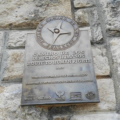Since 2023, the Way of Saint James crosses the Mediterranean Sea. This stretch of the legendary pilgrimage path is known as the Camino Maltés. It begins in Malta, joins the Cammino di San Giacomo in Sicily and continues with the Camminu di San Jacu in Sardinia until it reaches the Catalan Way, from Barcelona to Compostela.
Historical evidence makes it clear that the route is basically the same one that pilgrims have always used when crossing the Mediterranean on their way to the Holy Land –and back. In a commentary in an early 17th-century Liber Bullarum, Grand Master Alof Wignacourt offered the pilgrim John Benegas safe conduct from the cave of St. Paul in Rabat to other holy destinations, including Compostela.
The Maltese segment of Camino Maltés is quite intense. Even if it is relatively short (just 34 kilometers) one should abstain from covering it in a single day: you do not want to miss the opportunity to visit some of the most unique historical, cultural, and religious monuments in the Mediterranean –and, probably, in the whole world. There are more than 30 places of spiritual interest along the route, all of them easily accessible on foot.
The route begins in Rabat, at the cave of St. Paul. According to tradition, this is where the apostle stayed while in Malta. Next to it are the iconic catacombs of St. Agatha, the only Early Christian catacombs outside Italy.
From there, the pilgrim arrives in Mdina, the famed fortified city. Tradition claims its cathedral stands on the spot where the Roman governor Publius received the Apostle of the Gentiles. Other places of interest are the Church of the Carmel and the Monastery of St. Peter.

After crossing the Old Mdina Gate, pilgrims descend the hill of Saqqajja to admire the Loggia del Palio, where the Grand Master blessed the horse races in honor of St. Paul, and the Church of St. Mark.
Taking a country road that leads to Zebbug, one finds St. Gakbu’s chapel, another Jacobean chapel –one of the chapels used by the Coptic community of Malta. Once in Zebbug, at least three beautiful churches welcome those who pass by: the Chapel of the Annunciation, the Church of St. Philip, and the Church of Our Lady of Light.
The cammino finds the small village of Siggiewi and its noble church of St. Nicholas, and continues to Qrendi, admiring the medieval chapels of the Divine Providence and St. Nicholas along the way. Two other chapels mark the way: those of Our Lady of Grace and of St. Matthew. The neighboring natural reserve of Il-Maqluba, with its almost otherworldly crater, is literally the stuff legends are made of.
The route continues through Zurrieq, with two chapels dedicated to St. Catherine and St. Agatha, until it reaches Gudja, one of the many places in the Maltese archipelago rich in archaeological finds. There, the church of St. Mary in Bir Miftuh stands as a unique sample of Maltese Mediterranean medieval charm.
The cammino now leads pilgrims to Ghaxaq, with its beautiful baroque church of St. Mary, and eventually to Zejtun, where there are two points of interest for the pilgrim: the imposing church of St. Catherine (rightly known as the Cathedral of the South) and the church of St. Gregory, with its underground passage, witness to cruel yet heroic battles throughout history.
We reach the end of the route in Birgu. There, pilgrims find solace while admiring the Chapel of St. Clement, the Inquisitorial Palace and the Church-Museum of Our Lady of Damascus, until they reach the Castrum Maris, Fort Saint Angelo. From there, pilgrims get to the port of Marsa, hop on a ferry, and continue along the Way of St. James across Sicily.
The Maltese pilgrim’s card (Kredenzjal tal-Pellegrin) is available from XirCammini. For more information on how to get a Kredenzjal or for more details regarding this pilgrimage, follow this link.





